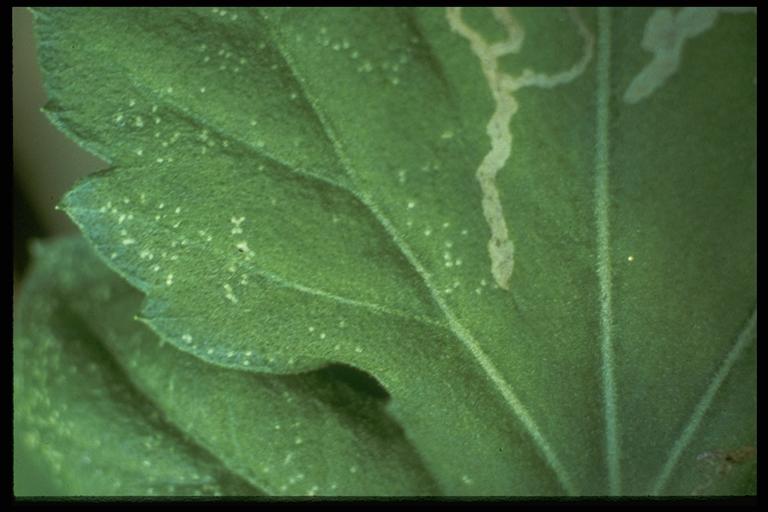
Serpentine leafminer, (Diptera: Agromyzidae), maggot damage to chrysanthemum. Photo by H. A. Turney.
Common Name: Leafminer flies
Scientific Name: Varies
Order: Diptera
Description: Adult L. trifolii flies are small (1/16 inch), appear superficially like house flies but have bodies overall gray-black with yellow markings. Maggots grow to be about 1/16 inch long and whitish yellow while the pupae are yellow-brown, oval and seed-like. Mines appear snake-like or “serpentine”, being narrow in width towards the end produced by younger maggots, and becoming progressively wider or blotch-like towards the end produced by larger mature maggots.
Other species of leafminer flies occur in the state. One species attacks the base of Louisiana iris leaves. A number of other insects have immature stages that produce serpentine- or blotch-shaped mines on leaves of host plants, including some species of beetles (Coleoptera: Chrysomelidae); sawflies (Hymenoptera: Tenthredinidae) and moths (Lepidoptera: several families) (see Tomato Pinworm).
Life Cycle: Mated L. trifolii females produce punctures or “stipples” on leaves with their egg laying structure (ovipositor) and uses some of these feeding sites into which to insert an egg and others to feed upon. Maggots hatch from eggs in about 2 days, and develop through three stages (instars) while producing the mine over a period of 7 to 8 days. The last stage emerges from the leaf and drops to the ground where is inflates its last skin to for the pupa or puparium. Adult flies emerge from the puparium in 7 to 11 days. Duration of the life cycle varies with temperature and time of the year. In the greenhouse, leafminers can breed throughout the year.
Habitat and Food Source(s): Modified chewing or “tissue-teasing” mouthparts on maggots; lapping house fly type mouthparts on adults. L. trifolii is primarily a pest of greenhouse plants including a wide variety of nursery crops (e.g., aster, chrysanthemum, dahlia, daisy, marigold, petunia, sunflower, zinnia) and vegetables (e.g., beans, cantaloupe, carrots, celery, cucumber, eggplants, lettuce, peas, and potatoes). Leaves are damaged as maggots tunnel through the inner leaf tissue (between the upper and lower leaf surface) producing whitish “mines”, that reduces the energy-producing (photosynthetic) surface area. High levels of damage on vegetable crops cause stunted growth and reduced yield; leafy vegetable crops like lettuce, and ornamental plants become unsightly and occasionally unmarketable. High populations of adult flies can injure leaves by producing egg-laying and feeding scars called “stipples.” Adult leafminer flies are attracted to yellow cards coated with a sticky layer (yellow sticky cards).
Pest Status: Immature stages (maggots or larvae) tunnel through leaf tissue causing whitish winding tunnels or “mines”, which can reduce yield and cause plants to look unsightly. Common species include: the “chrysanthemum leafminer”, Liriomyza trifolii (Burgess); the serpentine leafminer, L. brassicae (Riley); and the vegetable leafminer, L. sativae Blanchard.
For additional information, contact your local Texas A&M AgriLife Extension Service agent or search for other state Extension offices.
Literature: Carter et al. 1982; Johnson & Lyon 1988.